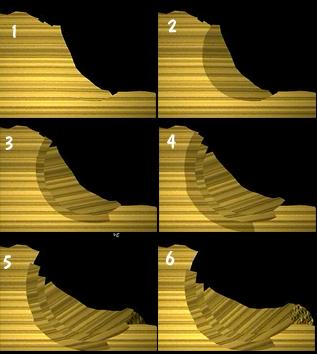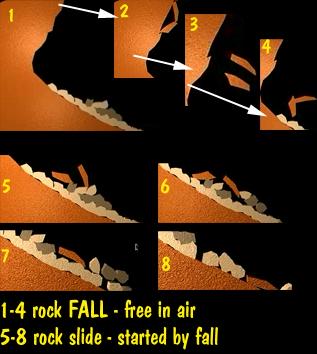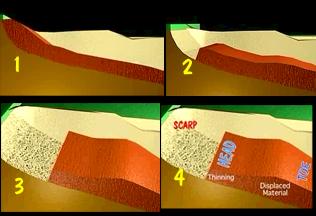

Slumps are concave-up movements that may happen when the underlying materials becomes saturated with water. If there has been alteration at the base (usually by man or additional water action) then this may be sufficient to cause the slump to occur.
Slumps are usually the result of a saturated or water weakened hill side and a weakened base. Slumps require a sedimentary base and do not happen when there is strong bedrock behind.
Slides and falls can happen when the supporting material is very stable, and will not give way. A fall is when rock separate from its surrounding material and actually takes flight.
As we saw in previous chapters (weathering) it is possible for the ice-thaw cycle to tear rock away by expanding crack structures. Some rock cliff faces may release by weathering and small to very large pieces of the cliff may give way and fall.
These rocks pick up velocity and may strike the ground at high speed and with a good deal of force. At the base of such cliffs there are often talus slopes (slopes that are made of fragments from previous falls). The new falling material may be sufficient to start a slide.
The slide is the motion of the debris on top of a solid surface down the hill. The rocks break free, move over one another until they achieve a new resting place and correct their angle of repose. (the angle at which stability is once again achieved.) The angle of repose is typically between about 30 and 37 degrees.
Creep is a very slow movement of material. It is so slow it cannot be seen, but can be measured on a movement per year basis. Creep typically occurs in regolith that is made up of broken fragments and not rounded or worn stones.
Creep may take place over wide areas, and although slow, the weight involved may be massive. Creep can move a roadway, fences, telephone poles, etc. It is just a very slow process.
Slow moving flows of unsorted material are known as colluvium. They can be recognized and separated from sedimentary layers because they have poor sorting, and are made up of non-rounded particles.

Flows
A flow acts more like a movement surrounded by liquid, although a liquid does not need to be present. A flow is a down slope movement that has a tumbling leading edge. It sort of looks like a wall of material being pushed downward with a rolling action.
Flows run the gambit from being really slow (cm per year) to very fast (100 km/hr). The weight of the leading edge of a flow can be tremendous and can easily crush structures, or move anything in their way (cars, trucks, buildings, etc.)
Earth flows like most flows, are usually made up of weak regolith, and are often made up of silt and clays particles. They are usually associated with some type of "fluid phenomena". The land becomes saturated with rain, or trapped air acts like a fluidized layer. At the top (the head) the remaining material after the flow as subsided is usually thinner than it was originally, most of the lost material is added to the center or lower regions of the flow. The bottom end (toe) my or may not be thickened.
They are usually long and narrow, and leave a tale-tale scarp at the top. A steep cliff where the flow detached from the slope. They may be triggered by rain or run-off. They may also be triggered by earthquake.
| NEXT | TOC | PREV |